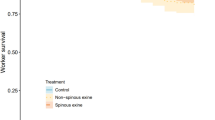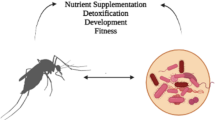Abstract
Epizootics of nucleopolyhedrovirus characterize declines of cyclic populations of western tent caterpillars, Malacosoma pluviale californicum. In field populations, infection can be apparently lacking in one generation and high in the next. This may suggest an increase in the susceptibility to infection of larvae at peak density or the triggering of a vertically transmitted virus. Here, we test the hypothesis that reduced food availability, as may occur during population outbreaks of tent caterpillars, influences the immunocompetence of larvae and increases their susceptibility to viral infection. We compared immunity factors, hemolymph phenoloxidase and hemocyte numbers, and the susceptibility to nucleopolyhedroviral infection of fifth instar larvae that were fully or partially fed as fourth instars. To determine if maternal or transgenerational influences occurred, we also determined the susceptibility of the offspring of the treated parents to viral infection. Food limitation significantly reduced larval survival, development rate, larval and pupal mass, moth fecundity and levels of hemolymph phenoloxidase, but not the numbers of hemocytes. Neither the food-reduced larvae nor their offspring were more susceptible to viral infection and were possibly even less susceptible at intermediate viral doses. Food reduction did not activate latent or covert viral infection of larvae as might be expected as a response to stress. We conclude that reducing the food intake of fourth instar larvae to an extent that had measurable and realistic impacts on their life history characteristics was not translated into increased susceptibility to viral infection.



Similar content being viewed by others
References
Beisner BE, Myers JH (1999) Population density and transmission of virus in experimental populations of the western tent caterpillar. Environ Entomol 28:1107–1113
Ben-Ami F, Ebert D, Regoes RR (2010) Pathogen dose infectivity curves as a method to analyze the distribution of host susceptibility: a quantitative assessment of maternal effects after food stress and pathogen exposure. Am Nat 175:106–115
Berryman A (1996) What causes population cycles of forest Lepidoptera? Trends Ecol Evol 11:28–32
Burden JP et al (2003) Covert infections as a mechanism for persistence of baculoviruses. Ecol Lett 6:524–531
Cerenius L, Lee BL, Söderhäll K (2008) The proPO-system: pros and cons for its role in invertebrate immunity. Trends Immunol 29:263–271
Cory JS, Hoover K (2006) Plant-mediated effects in insect-pathogen interactions. Trends Ecol Evol 21:278–296
Cory JS, Myers JH (2003) The ecology and evolution of baculoviruses. Annu Rev Ecol Evol Syst 34:239–272
Cory JS, Myers JH (2009) Within and between population variation in disease resistance in cyclic populations of western tent caterpillars: a test of the disease defence hypothesis. J Anim Ecol 78:646–655
De Block M, Stoks R (2008) Short term larval food stress and associated compensatory growth reduce adult immune function in a damselfly. Ecol Entomol 33:796–801
Diamond S, Kingsolver J (2010) Host plant quality, selection history and trade-offs shape the immune response of Manduca sexta. Proc R Soc Lond B 278:289–297
Dwyer G, Dushoff J, Elkinton JS, Levin SA (2000) Pathogen-driven outbreaks in forest defoliators revisited: building models from experimental data. Am Nat 156:105–120
Dwyer G, Firestone J, Stevens TE (2005) Should models of disease dynamics in herbivorous insects include the effects of variability in host-plant foliage quality? Am Nat 165:18–31
Ericsson JD, Janmaat AF, Lowenberger C, Myers JH (2009) Is decreased generalized immunity a cost of Bt resistance in cabbage loopers Trichoplusia ni? J Invertebr Pathol 100:61–67
Fuxa JR, Sun JZ, Weidner EH, LaMotte LR (1999) Stressors and rearing diseases of Trichoplusia ni: evidence of vertical transmission of NPV and CPV. J Invertebr Pathol 74:149–155
Gillespie JP, Kanost MR, Trenczek T (1997) Biological mediators of insect immunity. Annu Rev Entomol 42:611–643
Haukioja E (1980) On the role of plant defenses in the fluctuation of herbivore populations. Oikos 35:202–213
Haukioja E (2005) Plant defenses and population fluctuations of forest defoliators: mechanism-based scenarios. Ann Zool Fenn 42:312–325
Hoover K et al (1998) Inhibition of baculoviral disease by plant-mediated peroxidase activity and free radical generation. J Chem Ecol 24:1949–2001
Inchausti P, Ginzburg LR (2009) Maternal effects mechanism of population cycling: a formidable competitor to the traditional predator-prey view. Philos Trans R Soc Lond B 364:117–124
Kendall BE et al (2005) Population cycles in the pine looper moth: dynamical tests of mechanistic hypotheses. Ecol Monogr 75:259–276
Klemola N, Klemola T, Rantala MJ, Ruuhola T (2007a) Natural host plant quality affects immune defence of an insect herbivore. Entomol Exper Appl 123:167–176
Klemola T, Klemola N, Andersson T, Ruohomaki K (2007b) Does immune function influence population fluctuations and level of parasitism in the cyclic geometrid moth? Popul Ecol 49:165–178
Klemola N, Kapari L, Klemola T (2008) Host plant quality and defence against parasitoids: no relationship between levels of parasitism and a geometrid defoliator immunoassay. Oikos 117:926–934
Klemola N, Anderson T, Ruohomäki K, Klemola T (2010) Experimental test of parasitism hypothesis for population cycles of a forest lepidopteran. Ecology 91:2506–2513
Lee KP, Cory JS, Wilson K, Raubenheimer D, Simpson SJ (2006) Flexible diet choice offsets protein costs of pathogen resistance in a caterpillar. Proc R Soc Lond B 273:823–829
Lee KP, Simpson SJ, Wilson K (2008) Dietary protein-quality influences melanization and immune function in an insect. Funct Ecol 22:1052–1061
Lochmiller RL (1996) Immunocompetence and animal population regulation. Oikos 76:594–602
Lord JC (2010) Dietary stress increases the susceptibility of Tribolium castaneum to Beauveria bassiana. J Econ Entomol 103:1542–1546
McCallum H, Barlow N, Hone J (2001) How should pathogen transmission be modelled? Trends Ecol Evol 16:295–300
McNeil J, Cox-Foster D, Slavicek J, Hoover K (2010) Contributions of immune responses to developmental resistance in Lymantria dispar challenged with baculovirus. J Insect Physiol IP-2456:11
McVean RIK, Sait SM, Thompson DJ, Begon M (2002) Dietary stress reduces the susceptibility of Plodia interpunctella to infection by a granulovirus. Biol Control 25:81–84
Moret Y, Schmid-Hempel P (2000) Survival for immunity: the price of immune system activation for bumblebee workers. Science 290:1166–1168
Murray KD, Elkinton JS (1990) Transmission of nuclear polyhedrosus-virus to gypsy moth (Lepidoptera, Lymantridae) eggs via contaminated substrates. Environ Entomol 19:662–665
Myers JH (1988) Can a general hypothesis explain population cycles of forest Lepidoptera. Adv Ecol Res 18:179–242
Myers JH (1993) Population outbreaks in forest Lepidoptera. Am Sci 81:240–251
Myers JH (1998) Synchrony in outbreaks of forest Lepidoptera: a possible example of the Moran effect. Ecology 79:1111–1117
Myers JH (2000) Population fluctuations of western tent caterpillars in southwestern British Columbia. Popul Ecol 42:231–241
Myers JH, Willams KS (1987) Lack of short or long term inducible defenses in the red alder: western tent caterpillar system. Oikos 48:73–78
Nilssen AC, Tenow O, Bylund H (2007) Waves and synchrony in Epirrita autumnata/Operophtera brumata outbreaks. II. Sunspot activity cannot explain cyclic outbreaks. J Anim Ecol 76:269–275
Plymale R, Grove MJ, Cox-Foster D, Stiguy N, Hoover K (2008) Plant-mediated alteration of the peritrophic matrix and baculovirus infection in lepidopteran larvae. J Insect Physiol 54:737–749
Povey S, Cotter SC, Simpson SJ, Lee KP, Wilson K (2009) Can the protein costs of bacterial resistance be offset by altered feeding behaviour? J Anim Ecol 78:437–446
Reeson AF, Wilson K, Gunn A, Hails RS, Goulson D (1998) Baculovirus resistance in the noctuid Spodoptera exempta is phenotypically plastic and responds to population density. Proc R Soc Lond B 265:1787–1791
Rothman LD, Myers JH (1994) Nuclear polyhedrosis virus treatment effect on reproductive potential of western tent caterpillar (Lepidoptera: Lasiocampidae). Environ Entomol 23:864–869
Rothman LD, Myers JH (1996a) Debilitating effects of viral diseases on host Lepidoptera. J Invertebr Pathol 67:1–10
Rothman LD, Myers JH (1996b) Is fecundity correlated with resistance to viral disease in the western tent caterpillar? Ecol Entomol 21:396–398
Saejeng A, Tidbury H, Siva-Jothy MT, Boots M (2011) Examining the relationship between hemolymph phenoloxidase and resistance to a DNA virus, Plodia interpunctella granulosis virus (PiGV). J Insect Physiol 56:1232–1236
Schott T, Hagen SB, Ims RA, Yoccoz NG (2010) Are population outbreaks in sub-arctic geometrids terminated by larval parasitoids? J Anim Ecol 79:701–708
Selas V, Hogstad O, Kobro S, Trond R (2004) Can sunspot activity and ultraviolet-B radiation explain cyclic outbreaks of forest moth pest species? Proc R Soc Lond B 27:1897–1901
Shelby KS, Popham HJR (2006) Plasma phenoloxidase of the larval tobacco budworm, Heliothis virescens, is virucidal. J Insect Sci 6:1–13
Shikano I, Ericsson JD, Cory JS, Myers JH (2010) Indirect plant-mediated effects on insect immunity and disease resistance in a tritrophic system. Basic Appl Ecol 11:15–22
Siva-Jothy MT, Thompson JJW (2002) Short-term nutrient deprivation affects immune function. Physiol Entomol 27:206–212
Strand MR (2008) The insect cellular immune response. Insect Sci 15:1–14
Trudeau D, Washburn JO, Volkman LE (2001) Central role of hemocytes in Autographa californica M nucleopolyhedrovirus pathogenesis in Heliothis virescens and Helicoverpa zea. J Virol 75:996–1003
Turchin P et al (2003) Dynamical effects of plant quality and parasitism on population cycles of larch budmoth. Ecology 84:1207–1214
Vilaplana L, Wilson K, Redman EM, Cory JS (2010) Pathogen persistence in migratory insects: high levels of vertically-transmitted baculovirus infection in field populations of the African armyworm. Evol Ecol 24:147–160
Washburn J, Kirkpatrick B, Volkman L (1996) Insect protection against viruses. Nature 383:767
Wellington WG (1960) Qualitative changes in natural populations during changes in abundance. Can J Zool 38:289–314
Wellington WG (1965) Some maternal influences on progeny quality in the western tent caterpillar, Malacosoma pluviale (Dyar). Can Entomol 97:1–14
Yang S, Ruuhola T, Rantala MJ (2007) Impact of starvation on immune defense and other life-history traits of an outbreaking geometrid, Epirrita autumnata: a possible causal trigger for the crash phase of population cycle. Ann Zool Fenn 44:89–96
Acknowledgments
We wish to thank Ian Bishop, Jutta Buchhop, Ishwarya Chaitanya, Aimee Gibson, Kelsie Hardman, Adrian McKay, and Christal Nieman for help with rearing and bioassays, and Tero Klemola and other referees for helpful comments on the manuscript. This research was supported by the Natural Science and Engineering Research Council grants to Judith Myers and Jenny Cory.
Author information
Authors and Affiliations
Corresponding author
Additional information
Communicated by Klaus Fischer.
Rights and permissions
About this article
Cite this article
Myers, J.H., Cory, J.S., Ericsson, J.D. et al. The effect of food limitation on immunity factors and disease resistance in the western tent caterpillar. Oecologia 167, 647–655 (2011). https://doi.org/10.1007/s00442-011-2023-z
Received:
Accepted:
Published:
Issue Date:
DOI: https://doi.org/10.1007/s00442-011-2023-z




